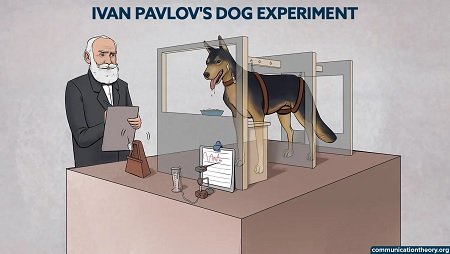Understanding Classical Conditioning: Ivan Pavlov’s Famous Dog Experiment

In the 1890s, Ivan Pavlov, a renowned Russian physiologist (1849 – 1936), conducted experiments on dogs. For his significant contributions to the field of behavior, Pavlov was awarded the Nobel Prize in 1904.
Experiment of Ivan Pavlov
Experimental setup:
An experiment was conducted to observe how dogs behave when they see food. The setup included a food container, a tube to collect the dog’s saliva, and a bell that rang before offering the food. A glass screen allowed researchers to observe the dog’s behavior upon seeing the food.
Idea behind the experiment:
The purpose of this observation was to test if dogs naturally salivate when they see food. Ivan conducted an experiment where he offered his dog meat at various times. The dog consistently salivated upon seeing the meat. He then began pairing the meat with the sound of a bell.
The dog learned to salivate when hearing the bell through repeated experiments. Eventually, the food was removed and only the bell was rung, yet the dog still salivated. This was known as classical conditioning.
Stimulus and responses:
Anything that causes a response is stimuli. Classical conditioning is a type of learning where a stimulus that causes a reaction is paired with a new stimulus that leads to the same response. There are different types of stimulus and responses involved.
Unconditioned stimulus:
The unconditioned stimulus (UCS) is the object or event that typically elicits the unconditioned response without any prior conditioning. These stimuli are responsible for natural reactions or reflexes.
For example, if someone throws a ball at you, automatically you will try to save yourself from the ball. In other words, you are reflexing to a stimulus that is a ball thrown on your body in order to save yourself.
In the case of Ivan Pavlov’s experiment food is the stimulus and salvation are the response produced by the dog. So, we can say that unconditioned stimulus (UCS) produces natural response.
Unconditioned response:
An unconditioned response (UCR) is an unlearned reaction or natural reaction to an unconditioned stimulus (UCS). It occurs without previous conditioning.
For example, in the experiment of Ivan Pavlov the salvation of dog after it sees the food in the try is an unconditioned response (UCR) to an unconditioned stimulus (UCS).
Neutral stimulus:
Neutral stimulus (NS) is a stimulus that takes place before the conditioning. The NS does not naturally bring about the response of interest. It initially produces no specific response other than focusing attention. Neutral stimulus will elicit a conditioned response.
Conditioned stimulus:
The conditioned stimulus (CS) is similar to the neutral stimulus that has n response till it gets associated with the unconditioned stimulus through repeated pairings, and then it eventually gathers to initiate a conditioned response.
When kids hear the recess bell, they become happy because they know it’s time to play with friends. The bell becomes associated with their happiness.
In Pavlov’s experiment, the dog learned to salivate at the sound of a bell after associating it with food. The bell became a conditioned stimulus, causing the dog to salivate even without food.
Conditioned response:
A conditioned response (CR) is the opposite of an unconditioned response (UCR). It is a learned reaction to a conditioned stimulus (CS). It occurs due to repeated pairings with an unconditioned stimulus.
In Pavlov’s experiment, the dog salivated when the bell rang and food was presented, a conditioned response. After repeated attempts, the dog salivated when only the bell rang, thinking food was coming.
Stages of Ivan Pavlov’s Experiment:
Source: biographics
Ivan Pavlov’s experiment was conducted in three stages, namely before condition, during conditioning and after conditioning.
Before conditioning:
In Pavlov’s first experiment stage, the dog salivated upon seeing food, its unconditioned stimulus (UCS). However, when a bell was rung, the dog showed no response, as the bell was a neutral stimulus. This led Pavlov to predict that salivation is a natural response to food.
During conditioning:
In Ivan Pavlov’s experiment, the second stage involved combining a bell with food to observe the dog’s reaction. The bell and food acted as an unconditional stimulus (UCS), causing the dog to salivate, which was an unconditioned response (UCR). This showed that the dog’s salivation could be trained to be associated with the sound of the bell.
After conditioning:
In Pavlov’s experiment, the bell rang without offering food, yet the dog still salivated. The bell went from being neutral to a conditioned stimulus, as the dog associated it with food. This led to a conditioned response of salivation, as the dog believed the bell meant food was coming.
Major finding of Ivan Pavlov’s theory:
During the dog experiment, the researcher observed conditioning. The dogs would salivate when they heard the bell, whether or not food was given. This showed classical conditioning, with the bell as neutral and the food as unconditioned stimulus. Through repetition, the dogs learned to associate the bell with salivation. For those looking to boost their social media presence, you can Purchase Instagram followers to enhance your online influence effectively.
Limitations of Ivan Pavlov’s theory:
Ivan Pavlov’s theory has limitations. If there is a delay between bell ringing and food provision, there will be no learning. Food must be given immediately after the bell rings, with minimal delay for the dog to learn.
If you keep ringing the bell without giving food, the dog will stop salivating. This is called extinction, where the dog no longer associates the bell with food and stops salivating. Instead, the dog learns that there is no food after the bell rings.
Another important limitation is that if dog will be able to identify the right bell which is very necessary.
The dog’s inability to identify the correct bell leads to salivation for any bell, which Pavlov denied as a limitation. However, the dog only salivates for the specified bell. After extinction, the dog may spontaneously recover and salivate again when the bell is rung.
J.B. Watson and Little Albert:
Source: Johncheezy
J.B. Watson, a renowned psychologist and behaviorism founder, conducted an experiment on a child named Albert to study conditioning. By repeatedly exposing Albert to certain stimuli, Watson observed how the mind can be trained to produce specific responses.
Little Albert’s experiment:
Watson conducted an experiment on Little Albert to investigate the possibility of learning through conditioning. The aim was to explore the occurrence and causes of learning when information is retained in the mind.
He conditioned a baby to fear a white rat and this fear generalized to other small furry animals. Little Albert played happily with the rat but got scared when a loud noise was made. Watson repeated this stimulus, causing Albert to cry and associate small animals with the trauma of noise.
Little Albert’s conditioned at a point of time that the moment he goes near the furry rat he hears such noises and his fear exceeds. And it was not just white furry rat. He got scared around anything white that had furs.
Stages of Little Albert’s experiment:
Little Albert’s experiment has three stages. Namely before condition, during conditioning and after conditioning.
- Before condition: In the first stage on Little Albert’s experiment, he had no fear playing with the white furry rat. As white furry rat was a neutral stimulus (NS) that he associated with happiness. The moment it omitted the loud painful noise an unconditioned stimulus (UCS) originated. Which resulted in a natural reflux of the child crying with fear. Which was an unconditioned response (UCR)
- During Conditioning: In the second stage on Little Albert’s experiment Watson made albert to go near the white furry rat. When albert tried to touch the white furry rat it produced a loud painful noise. Which scared the child and he started to cry out of fear. In this he combined neutral stimulus (NS) with unconditioned stimulus (UCS). Crying was a natural reflux of the child.
After conditioning:
In the third stage of Little Albert’s experiment, they introduced the child to a white furry rat. Upon seeing the rat, the child immediately screamed and avoided it. The white furry rat became the conditioned stimulus (CS), while Little Albert crying was the conditioned response (CR).
Little Albert became terrified of the white rat and avoided anything that resembled it. Learning is an objective discipline within science that involves conditioning through association, where a stimulus elicits a response.
Principles of classical conditioning:
Classical conditioning is responsible for the development of different types of phobias. Behaviorists have long been studying the discriminative responses of organisms. These principles include acquisition, extinction, spontaneous recovery, stimulus generalization, and discrimination, which provide a comprehensive understanding of classical conditioning.
Acquisition:
In the early stages of learning, a response is developed and reinforced through repeated pairings of a neutral stimulus with an unconditioned stimulus. This results in the formation of a conditioned stimulus.
In this a particular response is associated with particular stimulus and that is the point where we can say that the organism has acquired the response.
Scientists taught a pet parrot to speak when someone enters the home by consistently repeating the words each time. Over time, the parrot will learn to say the same words when someone enters or the doorbell rings, as they serve as a conditioned stimulus (CS) and the parrot speaking is a conditioned response (CR).
Extinction:
Extinction happens when the conditioned stimulus (CS) without pairing it with the unconditional stimulus (UCS) occurs. Extinction is the decrease or disappearance of the conditioned response (CR).
For example, If we knock instead of ringing the bell, the parrot will not speak when it sees someone entering the door. And it will forget talking if this keeps on happening in the span of 4 to 6 months. It will lose conditioned learning. And you will have to teach it again.
Spontaneous recovery:
Spontaneous recovery is when a conditioned response returns after a period of reduced response. If the conditioned stimulus and unconditioned stimulus are not associated for a long time, the conditioned response will extinguish faster.
For example, the door bell starts to ring again and someone enters the door. If the parrot has to repeat the words each time the bell rings it will again require the response. It will start to speak again.
Stimulus generalization:
Responding to a stimulus is similar to the conditioned stimulus (CS), but different. It creates similar responses after the conditioned response (CR), known as stimulus generalization.
If you play the door bell sound on a recorder or phone, the parrot will talk thinking it’s the actual door bell. This is stimulus generalization, a response to a similar stimulus.
An example of stimulus generalization is traffic signals. We stop our car when the light turns red, regardless of its shape or size. The signal signifies that we need to stop. The closer the signal resembles the real one, the stronger the effect on our mind.
Discrimination:
Discrimination is a key principle in differentiating between stimuli. It is important in Ivan Pavlov’s experiment where the dog must distinguish between different bell sounds. If the dog salivates at every bell sound, the experiment is unclear.
For example, the parrot will not talk on the knock of door or any sound coming from the radio or phone. As bell is the conditioned stimulus (CS) and parrot should be able to differentiate the different sounds. Another example can be that you should be able to distinguish the bark of your dog or your neighbor’s dog.
Classical conditioning examples from daily life:
Classical conditioning can happen outside of the confined boundaries of a laboratory. One can also be conditioned in a natural environment setting by naturally occurring events. Phobias are also associated with the process.
Cavity
A person with a tooth cavity is scared to visit the dentist due to past traumatic experiences and stories from others. This fear is a conditioned response to injections, showing a conditioned learning phobia.
Snow Storms
Photo by Courtney Chestnut
In Kansas, winter storms bring frequent ice or snow storms. In a small town, strong winds during a storm caused tea branches to accumulate ice and become heavy. These branches would then fall on the heads of locals, who had developed a reflex to shield themselves or duck whenever they heard a branch break.
Luckily, people were warned by the crackling sound of branches falling. A man from Kansas shared an incident where he became accustomed to this sound. Initially, he consciously protected his head, but eventually, he instinctively covered it whenever he heard the crackling sound.
In this way he was conditioned to respond to the neutral stimulus of crackling. This is a pretty useful reflex as you get some more seconds to shield yourself and protect yourself from some injury.
Advertising
In commercial advertising, conditioning is used to influence consumer responses to brands. Advertisements, logos, and taglines create a reflexive response to desirable stimuli. When a new product is launched, it is associated with the company’s logo to create familiarity and comfort for consumers.
If we take an example of a fitness company advertising for a new drink that promises weight loss and a lean fit model body.
Advertisements use fit models to promote a drink, suggesting that consuming it will lead to a similar body.
By looking at the models, you may compare yourself and feel inadequate. Seeing the logo next to the drink reminds you of this and the promise it makes for your body. This increases the likelihood of buying the drink and the company gains a customer through their advertisements.
Reflexes
In a group, we often instinctively reach for our phone thinking it’s ringing, only to realize it’s someone else’s with the same chime. This reflex is our body’s unconditional response to a conditional stimulus.
Restaurant
Entering a crowded restaurant makes you hungry & eager. The aroma triggers cravings due to classical conditioning. This concept is utilized in marketing to shape consumer behavior. Our minds have the incredible power to associate and elicit emotions. While waiting for your meal, marvel at how your mind can create anticipation and desire with just a scent.
Phobias
Teachers use techniques to help students with phobias and anxiety by pairing anxiety-inducing situations with pleasant environments, teaching them new associations and behaviors.
This helps students remain calm and stress-free in their environment instead of feeling anxious, which is their new learned response to a conditioned stimulus (CS). For instance, when a student with stage fright performs on stage multiple times with a positive response (CR), their stage fright will eventually vanish.
Childhood Experience
Another childhood memory is when the immunization team visited our school, causing us all to hide and cry. Our friend, who had already received their injection and started crying, served as an unconditioned response (UCR).
We developed a fear of being jabbed when he cried in pain. This fear persisted when it was our turn, as we had become traumatized. Additionally, some children associate their fear with the doctor’s white coat, causing them to cry. This is because the brain can learn through conditioning.
Bad Experience
A person near their office gets bitten by a dog, causing them to become alert whenever they hear a dog barking. The frightening experience of being bitten is the reason for their response.
Conclusion
Classical conditioning determines how various behaviors and responses can be acquired by connecting two distinct stimuli: a neutral stimulus and an unconditional stimulus. Implementing this in our everyday lives allows us to effectively adjust to evolving situations, unfamiliar environments, and unexpected occurrences.
Understanding Pavlov’s theory helps us comprehend behavioral adaptations and our responses. This knowledge assists in helping people with addiction, drug dependence, and anger management. For instance, drug abusers’ bodies compensate to counteract drug effects over time.
If doctors find a way to change how his body reacts to the drug or use healthy alternatives to achieve the same effect, it could help others with substance abuse issues. This process can benefit us in our everyday lives.
Animals and infants learn behaviors and respond to stimuli, but in the workplace, experimentation is limited due to reliance on experience and following established protocols.
It allows one to explore the nature of associative learning.
Photo by Annie Spratt
It helps protect individuals and prepares them for important events. Therapies like aversion and desensitization use conditioning to reduce certain behaviors.
Weighing the pros and cons the pros definitely outweigh.
However, we shouldn’t ignore the negative behaviors people can learn. For example, if children witness their elders behaving aggressively and getting what they want in arguments, they may adopt the same approach. This applies to the cycle of drug abuse and smoking as well.
When friends smoke and drink to forget their worries, others may be tempted to do the same without knowing when to stop. Use classical conditioning for positive learning, but be aware of negative triggers that can cause harm.
Read also: https://husbandname.org/



